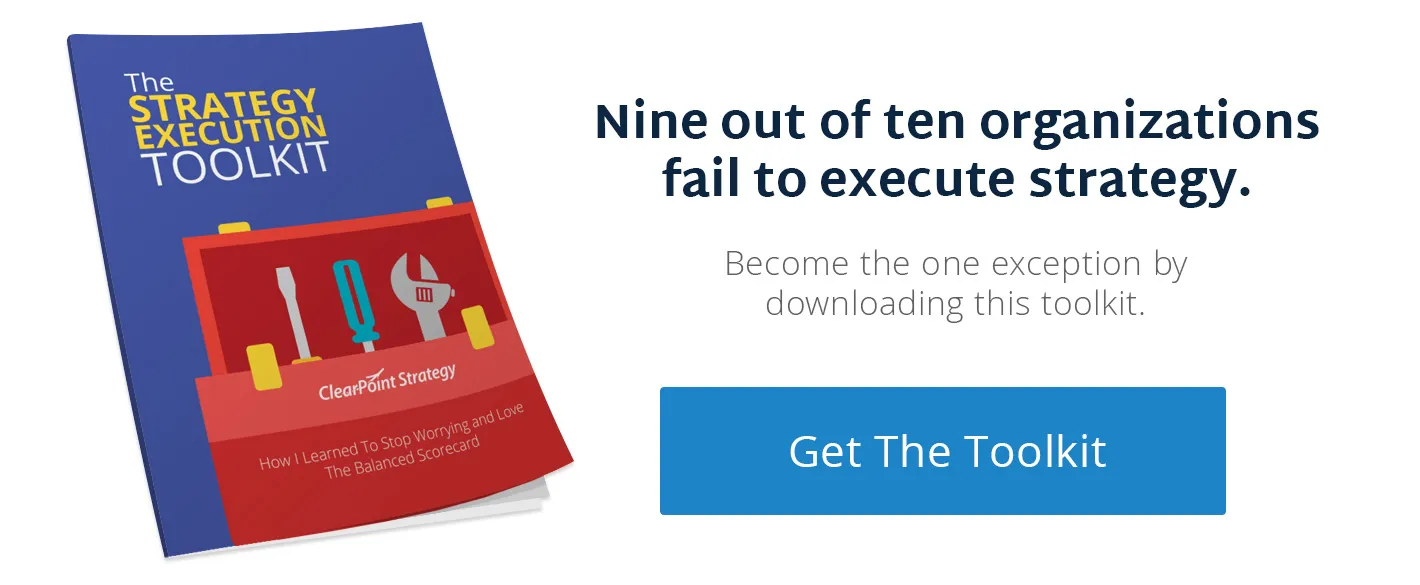Breaking Down The Three Levels Of Strategy In Any Business
%20(1).webp)
Understanding the levels of your business strategy can help align your company goals
“How ‘far down’ into the company does our strategy really need to go?” In other words, in what areas of the company should the groundwork for strategy be laid? This is a question we’ve heard repeatedly from people at companies that are either in the beginning phases of strategy creation or are updating an outdated strategy. Regardless of which of those two camps you belong to, you should have a clear understanding of the three levels of strategy in your business.
The Three Levels of Strategy
- Level 1: The Corporate Level
- Level 2: The Business Unit Level
- Level 3: The Functional Level
Having a solid understanding of these levels of strategy will help you break your strategy into the correct levels, so you can align your company-wide goals from the top of your organization (the corporate level) to the bottom (the functional level). Additionally, if you approach your strategy using these three levels, leaders across your organization will have a better understanding of how their strategic activities impact your company’s high-level strategy.
Strategy Level 1: The Corporate Level
The corporate level is the highest, and therefore the most broad, level of strategy in business. Corporate-level strategy should define your organization’s main purpose. It should also direct all your downstream decision-making. For example, the objectives (e.g. high-level goals) in the levels below this one should all have a direct line to the goals defined here.
Creating and understanding your corporate-level strategy is particularly important for organizations that have multiple lines of business. For example, if one arm of your business manufactures a product and another arm sells that product, you’ll have a separate business unit strategy for each—but one single corporate-level strategy that describes why those two arms are important, and how those businesses interact for the good of the organization.
There are a handful of things to do as you work on your corporate-level strategy:
1. Confirm your overall mission and vision. These two elements define your entire organization, and so should be done at the corporate level:
- Your mission statement describes what your company does and how it is different from other organizations in your competitive space.
- Your vision statement describes the desired future state of your organization at a certain point in time.
To create these elements, you may want to write out an OAS statement ( Objective, Advantage, Scope) or use a tool known as Strategic Shifts. You can read about both here.
2. Create your corporate objectives. Your objectives describe the high-level goals that will help you achieve your mission and vision. Take, for example, a bank. This bank used the Balanced Scorecard to outline objectives across four perspectives (from the top of the scorecard to the bottom): financial, customer, internal, and learning and growth (L&G). You can see their objectives written in the sample strategy map below.

Strategy Level 2: The Business Unit Level
Your business unit strategy is used for different areas of your business (like services and products, or multiple departments or divisions, for example). The complexity of this level will depend on how many businesses you are in, and how your company is structured. It’s important to create a strategy for each business unit so that you can see which units are excelling and which need improvement.
Having a strategy at the business unit level allows you to weigh the costs and benefits of each business unit and to decide where you should spend your resources. Depending on the progress towards your goals and your analysis of the market, you may even decide it’s time to divest or sell some of your business units so you can focus on the areas that are most important to achieving your company’s corporate strategy.
There are a few things to do as you work on your business unit strategies:
1. Differentiate yourself from your competitors. One of the best ways to tell if you’ve done this adequately is through a SWOT analysis, which allows you to review your competitive environment and define a strategy based on what sets your organization—and specifically, the business unit—apart from the competition.
Nine out of 10 organizations fail to execute strategy. Avoid failure with this toolkit.
2. Create objectives and initiatives that support your business unit and the corporate level. Your goal while creating a business unit strategy is to create objectives and initiatives that support the unit while simultaneously contributing to the objectives and initiatives of the organization as a whole. For example, at the corporate level for the learning and growth perspective, one of the bank’s main priorities (in the example above) is to “provide valuable skills training.” With this objective in mind, your business units will be able to determine what activities they’ll need to do to support this—like providing customer training services relevant to its specific function.
Strategy Level 3: The Functional Level
The functional level of your strategy involves each department—and what those at the department level are doing day-to-day to support corporate initiatives. Whereas your business unit strategy would be defined and evaluated by senior leadership, your functional strategy is typically produced by department heads (e.g. leaders in marketing, operations, finance, IT, etc.). These individuals can help ensure that the departments execute the defined strategic elements, and that the components laid out at the functional level help support both the department level and corporate level strategies.
There are a few things to consider as you work on your functional strategies:
1. Understand that this level has the most detailed measures and projects. Measures help you answer the question, “How are we doing toward meeting a particular objective?” Projects (or initiatives) help you answer, “What are the key actions we can take to support our objectives?” While you’ll have measures and projects at every level of your strategy, they should be extremely detailed at the functional level. You can leverage a RACI matrix to ensure everyone knows who is responsible for completing your projects and who they need to go to for help or direction.
2. Make sure the goals in your functional strategy align with the goals at the corporate level. Corporate goals are set by the most senior members of your organization, and those goals drive decision making. You’ll gain support from the top level of executives if your projects and goals align with their goals. You’ll also be able to see how the work you are doing contributes to the overall success of the company.
3. Don’t get too “measure happy.” We’ve seen organizations measure hundreds of data points at the functional level. But keep in mind what your bigger goals are and measure only the things that help you determine if you’re progressing toward those goals. (This blog gives detailed instructions on selecting the right measures, if you need a hand.)
Going back to our bank example, this organization may decide that, at the functional level, measuring the number of service calls responded to and the response time for customer service calls are the most effective measures for customer service training, which rolls up to support the skills training corporate-level initiative.
Don’t forget to constantly give and gather feedback as you create your strategies at every level.
Providing support and feedback during strategy creation is critical, as it’ll help those involved to fine-tune things and emphasizes the importance of the activity to the organization as a whole. And don’t forget to ask for feedback as well. For example, if customer service is a focus, talk to those who are actually speaking to the customers and gather concerns and comments from them as well.




.webp)
.webp)
.webp)
.webp)
.webp)
.webp)
.webp)
.webp)
.webp)
.webp)








.webp)

